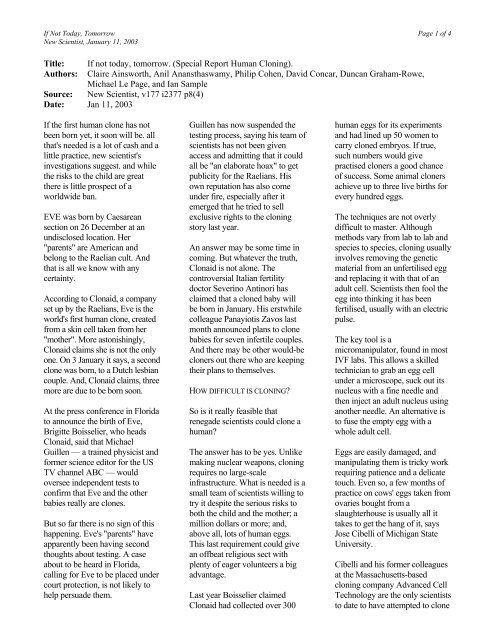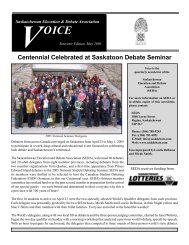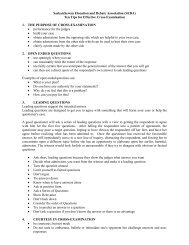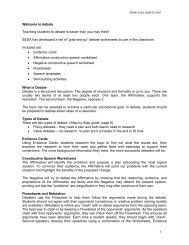Human Cloning - Saskatchewan Elocution and Debate Association
Human Cloning - Saskatchewan Elocution and Debate Association
Human Cloning - Saskatchewan Elocution and Debate Association
Create successful ePaper yourself
Turn your PDF publications into a flip-book with our unique Google optimized e-Paper software.
If Not Today, Tomorrow Page 1 of 4<br />
New Scientist, January 11, 2003<br />
Title: If not today, tomorrow. (Special Report <strong>Human</strong> <strong>Cloning</strong>).<br />
Authors: Claire Ainsworth, Anil Anansthaswamy, Philip Cohen, David Concar, Duncan Graham-Rowe,<br />
Michael Le Page, <strong>and</strong> Ian Sample<br />
Source: New Scientist, v177 i2377 p8(4)<br />
Date: Jan 11, 2003<br />
If the first human clone has not<br />
been born yet, it soon will be. all<br />
that's needed is a lot of cash <strong>and</strong> a<br />
little practice, new scientist's<br />
investigations suggest. <strong>and</strong> while<br />
the risks to the child are great<br />
there is little prospect of a<br />
worldwide ban.<br />
EVE was born by Caesarean<br />
section on 26 December at an<br />
undisclosed location. Her<br />
"parents" are American <strong>and</strong><br />
belong to the Raelian cult. And<br />
that is all we know with any<br />
certainty.<br />
According to Clonaid, a company<br />
set up by the Raelians, Eve is the<br />
world's first human clone, created<br />
from a skin cell taken from her<br />
"mother". More astonishingly,<br />
Clonaid claims she is not the only<br />
one. On 3 January it says, a second<br />
clone was born, to a Dutch lesbian<br />
couple. And, Clonaid claims, three<br />
more are due to be born soon.<br />
At the press conference in Florida<br />
to announce the birth of Eve,<br />
Brigitte Boisselier, who heads<br />
Clonaid, said that Michael<br />
Guillen — a trained physicist <strong>and</strong><br />
former science editor for the US<br />
TV channel ABC — would<br />
oversee independent tests to<br />
confirm that Eve <strong>and</strong> the other<br />
babies really are clones.<br />
But so far there is no sign of this<br />
happening. Eve's "parents" have<br />
apparently been having second<br />
thoughts about testing. A case<br />
about to be heard in Florida,<br />
calling for Eve to be placed under<br />
court protection, is not likely to<br />
help persuade them.<br />
Guillen has now suspended the<br />
testing process, saying his team of<br />
scientists has not been given<br />
access <strong>and</strong> admitting that it could<br />
all be "an elaborate hoax" to get<br />
publicity for the Raelians. His<br />
own reputation has also come<br />
under fire, especially after it<br />
emerged that he tried to sell<br />
exclusive rights to the cloning<br />
story last year.<br />
An answer may be some time in<br />
coming. But whatever the truth,<br />
Clonaid is not alone. The<br />
controversial Italian fertility<br />
doctor Severino Antinori has<br />
claimed that a cloned baby will<br />
be born in January. His erstwhile<br />
colleague Panayiotis Zavos last<br />
month announced plans to clone<br />
babies for seven infertile couples.<br />
And there may be other would-be<br />
cloners out there who are keeping<br />
their plans to themselves.<br />
HOW DIFFICULT IS CLONING?<br />
So is it really feasible that<br />
renegade scientists could clone a<br />
human?<br />
The answer has to be yes. Unlike<br />
making nuclear weapons, cloning<br />
requires no large-scale<br />
infrastructure. What is needed is a<br />
small team of scientists willing to<br />
try it despite the serious risks to<br />
both the child <strong>and</strong> the mother; a<br />
million dollars or more; <strong>and</strong>,<br />
above all, lots of human eggs.<br />
This last requirement could give<br />
an offbeat religious sect with<br />
plenty of eager volunteers a big<br />
advantage.<br />
Last year Boisselier claimed<br />
Clonaid had collected over 300<br />
human eggs for its experiments<br />
<strong>and</strong> had lined up 50 women to<br />
carry cloned embryos. If true,<br />
such numbers would give<br />
practised cloners a good chance<br />
of success. Some animal cloners<br />
achieve up to three live births for<br />
every hundred eggs.<br />
The techniques are not overly<br />
difficult to master. Although<br />
methods vary from lab to lab <strong>and</strong><br />
species to species, cloning usually<br />
involves removing the genetic<br />
material from an unfertilised egg<br />
<strong>and</strong> replacing it with that of an<br />
adult cell. Scientists then fool the<br />
egg into thinking it has been<br />
fertilised, usually with an electric<br />
pulse.<br />
The key tool is a<br />
micromanipulator, found in most<br />
IVF labs. This allows a skilled<br />
technician to grab an egg cell<br />
under a microscope, suck out its<br />
nucleus with a fine needle <strong>and</strong><br />
then inject an adult nucleus using<br />
another needle. An alternative is<br />
to fuse the empty egg with a<br />
whole adult cell.<br />
Eggs are easily damaged, <strong>and</strong><br />
manipulating them is tricky work<br />
requiring patience <strong>and</strong> a delicate<br />
touch. Even so, a few months of<br />
practice on cows' eggs taken from<br />
ovaries bought from a<br />
slaughterhouse is usually all it<br />
takes to get the hang of it, says<br />
Jose Cibelli of Michigan State<br />
University.<br />
Cibelli <strong>and</strong> his former colleagues<br />
at the Massachusetts-based<br />
cloning company Advanced Cell<br />
Technology are the only scientists<br />
to date to have attempted to clone





